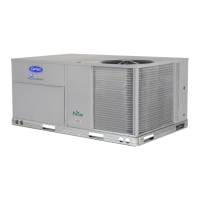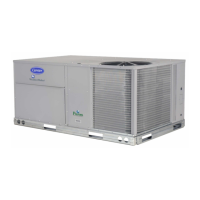79
If all of the above conditions are satisfied, Unoccupied Econo-
mizer Free Cooling will start when both of the following con-
ditions are true:
{SPT > (OCSP + 2)} AND {SPT > (OAT + 8)}
The Unoccupied Economizer Free Cooling Mode will stop
when either of the following conditions are true:
{SPT < OCSP} OR {SPT < (OAT + 3)} where SPT = Space
Temperature and OCSP = Occupied Cooling Set Point.
When the Unoccupied Economizer Free Cooling mode is ac-
tive, the supply fan is turned on and the economizer damper
modulated to control to the supply air set point (Setpoints
SASP) plus any supply air reset that may be applied (Inputs
RSET
SA.S.R).
OUTDOOR AIR CFM CONTROL
If an outdoor air cfm flow station has been installed, the econo-
mizer is able to provide minimum ventilation based on cfm, in-
stead of damper position. The outdoor air cfm reading can be
found in Inputs
CFM
O.CFM. During cfm control, the
economizer must guarantee a certain amount of cfm at any
time for ventilation purposes. If the outdoor air cfm measured
is less than the current calculated cfm minimum position, then
the economizer will attempt to open until the outdoor air cfm is
greater than or equal to this cfm minimum position. The fol-
lowing options are used to program outside air cfm control.
Outdoor Air cfm Sensor Enable (OCF.S)
If this option is enabled, the outdoor air cfm sensor will be read
and outside air cfm control will be enabled.
Economizer Minimum Flow Rate (O.C.MX)
This option replaces the Economizer Minimum Position (Con-
figuration
ECON
EC.MN) when the outdoor air cfm sen-
sor is enabled.
IAQ Demand Vent Minimum Flow Rate (O.C.MN)
This option replaces the IAQ Demand Ventilation Minimum
Position (Configuration
IAQ
DCV.C
IAQ.M) when the
outdoor air cfm sensor is enabled.
Economizer Minimum Flow Deadband (O.C.DB)
This option defines the deadband of the cfm control logic.
The configurable deadband is added to the economizer’s
minimum cfm position and creates a range (ECMINCFM to
ECMINCFM ± OACFM_DB) where the economizer will
not attempt to adjust to maintain the minimum cfm position.
Increasing this deadband value may help to slow down ex-
cessive economizer movement when attempting to control
to a minimum position at the expense of bringing in more
ventilation air than desired.
ECONOMIZER OPERATION CONFIGURATION
The configuration items in the E.CFG menu group affect how
the economizer modulates when attempting to follow an econ-
omizer cooling set point. Typically, they will not need adjust-
ment. In fact, it is strongly advised not to adjust these configu-
ration items from their default settings without first consulting
a service engineering representative.
In addition, the economizer cooling algorithm is designed to
automatically slow down the economizer actuator’s rate of
travel as outside air temperature decreases.
ECONOMIZER DIAGNOSTIC HELP
Because there are so many conditions which might disable the
economizer from being able to provide free cooling, the control
has a display table to identify these potentially disabling sources.
The user can check ACTV, the “Economizer Active” flag. If this
flag is set to Yes, there is no reason to check DISA (Economizer
Disabling Conditions). If the flag is set to No, this means that at
least one or more of the flags under the group DISA are set to
Yes and the user can discover what is preventing the economizer
from performing free cooling by checking the table.
The economizer’s reported and commanded positions are also
viewable, as well as outside air temperature, relative humidity,
enthalpy and dew point temperature.
The following information can be found under the Local Dis-
play Mode Run Status
ECON. See Table 65.
Fig. 12 — Custom Changeover Curve Example

